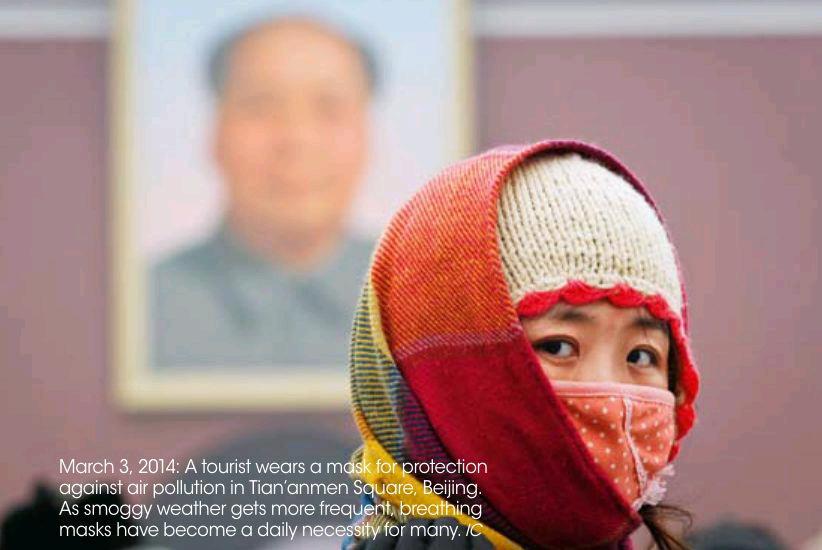Money in the Air
by+Zi+Mo
On February 17, 2014, the first weekday following Lantern Festival, when Beijing students returned to school after winter vacation, severe smog left them gasping for breath as they started the new semester.
When she picked up her son after school, Ms. Liu noticed a classroom window open despite the pollution. “My son told me the window was open all day,” she recalls, “but if they close all the windows, the classroom packed with over 40 students would be too stuffy. When I arrived home, I discussed this with other parents in my WeChat group, and one proposed to pool money to buy an air purifier for the classroom.” To her surprise, the proposal received enthusiastic support from parents of 35 students within three hours. As smoggy weather becomes increasingly frequent, sales of air purifying devices, including masks, have seen a boom in China.
Market Opportunities
In Climate Economics, German economic observer Friedhelm Schwarz illustrated the impact of climate and weather on economic behavior. The market boom triggered by smog in China is pristine evidence to support his theory.
Medical masks, which were developed for healthcare professionals and employees exposed to harmful dust, fumes, vapor or gas, have now become daily necessities due to the widespread smog in China. A search for“PM2.5 respirator” on Taobao.com, Chinas largest e-commerce website, produces a list of 30,000 products. Along with ordinary dust masks, consumers are picking up N95/ N99 surgical masks, and masks employing activated charcoal, anti-bacterials, and micro-filtration technology. A single Taobao vendor sold nearly 20,000 respirators over the last 30 days. Statistics show that on a one-day promotional campaign on November 11, 2013, “Green Shield”, the best-known mask brand on Tmall, a shopping site operated by Chinese e-commerce giant Alibaba, raked in 1.29 million yuan, setting the record for PM2.5 mask sales in a single day.
As public concern about smog grows, demand for household air pollution prevention devices such as air purifiers has been increasing with each passing year. According to statistics from All View Consulting, online sales of air purifiers totaled only 120 million yuan in December 2012, and the figure jumped to 610 million yuan in December 2013. Over the same period, offline sales increased from 210 million yuan to 1 billion yuan, up 480 percent. Bohai Securities estimates that the market size of household pollution prevention equipment including air purifiers will reach 80 billion yuan by 2015.
Smog prevention has become a selling point for other products too. Foods considered good for the lungs have also seen sales increases. Clean air is noted by travel agencies when recommending routes and by real estate developers publicizing projects.
Yet the greatest market opportunities arise from the Chinese governments efforts to combat air pollution. According to the Action Plan for Air Pollution Prevention and Control issued by the State Council, the country will invest a total of 1.75 trillion yuan to tackle air pollution, which is estimated to stimulate GDP growth by 2.39 trillion yuan, of which 1 trillion yuan will come from air pollution prevention and control industries. Industry insiders believe that this will generate an industrial cluster of various segments, each with a market size of 10 billion yuan.
Smogonomics
Market opportunities hidden behind air pollution control are great lure to capital, and investments in the field will stimulate the countrys GDP growth in the future. But, do we really need such smogbased business opportunities?
According to Toward an Environmentally Sustainable Future – Country Environmental Analysis of the Peoples Republic of China, co-published by Asian Development Bank and Tsinghua University, air pollution could be costing China as much as 1.2 percent of the entire countrys GDP based on cost-of-illness valuation and 3.8 percent of GDP based on willingness to pay.
Along with quantifiable losses, smog also makes an immeasurable impact on public psychology and mood. “The furthest distance in the world no longer separates life and death – Im holding your hand on the street, but I can barely see your face,”some have joked.
Despite the fact that his business profits come from smoggy weather, Zhao Danqing, founder of Green Shield PM2.5 masks, admits, “Every entrepreneur wants his product to stand out from its competitors and exist as long as possible in the market – except in my case. My product thrives on the precondition that the environment is devastated and human health is in danger. Frankly, my team and I both hope our product drops off Chinese bestselling lists as soon as possible.”
Although extensive economic development has led to fast GDP growth in China, the environment was sacrificed during the process. Now, efforts to tackle pollution may stimulate another surge of investment. However, such growth only has value on paper and hearkens to the “parable of the broken window” introduced by French political economist Claude Frédéric Bastiat to illustrate why destruction and money spent on recovery do not actually benefit society in the end. In fact, revenue from air pollution prevention cannot compensate for enormous losses that smog causes to the national economy and human health.
Essentially, smog is an ecological disaster. No matter how tremendous the market opportunities it may create, it never deserves praise. Prevention is better than a cure. Chinas only true long-term solution for smog is to change outdated economic development modes.
